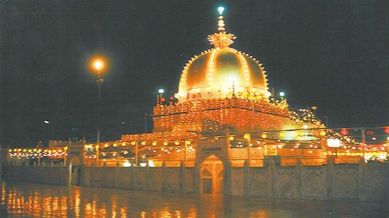📣 For more lifestyle news, click here to join our WhatsApp Channel and also follow us on Instagram
Ajmer Sharif Dargah: Rajasthan’s beacon of spiritual and cultural richness
Know more about the history, significance, annual celebrations and culinary delights you can enjoy while visiting the shrine

Nestled in the heart of Rajasthan, the Ajmer Sharif Dargah stands as a testament to spiritual harmony, cultural richness, and historical significance. The shrine of Khwaja Moin-ud-din Chishti, fondly known as Gharib Nawaz (Benefactor of the Poor), attracts millions of devotees from across the world, transcending religious boundaries.
It traces its origins to the late 12th century. According to historical records from the ‘Siyar-ul-Auliya’ (a comprehensive biography of Sufi saints), Khwaja Moinuddin Chishti arrived in Ajmer from Persia around 1192 CE, establishing the foundations of the Chishti Sufi order in India. His teachings emphasised universal love, peace, and spiritual equality.
monthly limit of free stories.
with an Express account.
According to the Rajasthan government’s tourism website, “In keeping with his secular teachings, its doors are open to people of all faiths and religions. Some say that Khwaja Moin-ud-din Chishti believed he was a direct descendant of Muhammad and preached his beliefs to the masses. While on his world travels, he was urged by Muhammad, in a dream, to visit India. He reached Ajmer, via Lahore, and made it his home from 1192 till his death in 1236 AD. The shrine was built by Mughal King Humayun in honour of this saint.”
Architectural marvel
The Dargah complex is a stunning example of Indo-Islamic architecture. The white marble shrine, adorned with intricate silver and gold decorations, reflects the architectural sophistication of the medieval period. The main gate, known as the Nizam Gate, was donated by the Nizam of Hyderabad in the 19th century, symbolising the widespread reverence for the saint.
According to Explore Rajasthan, this iconic monument is a “true representative of the Mughal style of architecture” with the structure of the Dargah having “the touches of Humayun to Shah Jahan.” The grave is encased within a silver railing and adorned with a marble screen. Nearby, a dedicated prayer room, constructed by Chimni Begum, the daughter of Shah Jahan, offers a serene space exclusively for women.
Spiritual significance
“The Ajmer Sharif Dargah is considered to be among the holiest Muslim shrines in India,” as mentioned by the Department of Tourism, Government of Rajasthan. What makes Ajmer Sharif unique is its universal appeal. Muslims, Hindus, Sikhs, and people from various backgrounds visit the shrine, seeking blessings and spiritual solace. The Dargah represents a profound example of religious tolerance and syncretism.
What’s more, several top Bollywood celebrities, including Shah Rukh Khan, Amitabh Bachchan, Kareena Kapoor Khan, Deepika Padukone, and others, have been seen visiting Ajmer Sharif to offer their prayers.
Annual celebrations
The Urs festival, commemorating the death anniversary of Khwaja Moin-ud-din Chishti, is the most significant event at the Dargah. Held annually for six days, the festival transforms Ajmer into a vibrant celebration of spirituality. Thousands of devotees from across the globe gather to pay homage, with qawwali performances, special prayers and offering chaddars (blankets) to the tomb.
Culinary delights: The street food experience
The area surrounding the Dargah is a culinary paradise. Narrow lanes are lined with food stalls offering traditional Rajasthani and Mughlai cuisine:
Mutton Nihari: A slow-cooked meat delicacy traditionally eaten for breakfast
Tandoori Dishes: Freshly prepared in traditional clay ovens
Mawa Kachori: A sweet delicacy unique to Rajasthan
Kehwa: Traditional Kashmiri green tea served hot
These food stalls are not just about sustenance but represent a cultural experience, where flavors tell stories of centuries-old culinary traditions.
Cultural impact
Beyond its religious importance, Ajmer Sharif has been a significant cultural and historical landmark. It has been a center of learning, spirituality, and cultural exchange for centuries. Scholars, poets, and travellers have been drawn to this place, contributing to its rich tapestry of stories and traditions.
Practical information for travellers
Location: Ajmer, Rajasthan, India
Timings: Open from early morning to evening
Best Time to Visit: Throughout the year, with special significance during the Urs festival
Entry: Free, but donations are welcome
Dress Code: Modest clothing recommended, head covering for both men and women
📣 For more lifestyle news, click here to join our WhatsApp Channel and also follow us on Instagram